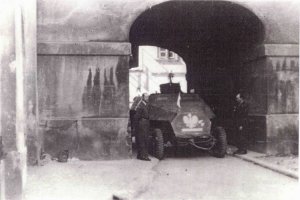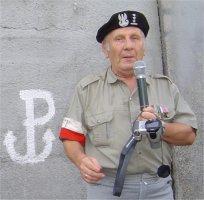
The Witnesses' Uprising Reports
Grenadierpanzerwagen - the first valuable capture
Saturday August 5th, Castle Square. Our soldiers sought out contact with the enemy, not having been troubled by hostile forces after shaking off the unsuccessful outcome of the first day of battle and after strengthening our own position.
A key point within range of our divisions was of course Castle Square, where despite restrictions we felt ourselves to be in possession of the terrain, which was documented in unique fashion by the white and red flag hung from the Royal Castle during the first day of the Uprising.
Within the limits of our free time, small groups of "hunters" came out onto Castle Square in order to hunt German cars attempting to slip from Krakow Suburbs Street (Krakowskie Przedmie¶cie) along New Exit (Nowy Zjazd) to the KerbedĽ Bridge. Around 4PM that day "Youngster" (Młodzik), along with "Tadeusz," stationed themselves around the plinth of Zygmunt's Column (This was possible until the 8th of August, when the Germans stationed a machine gun on the tower of St. Anne's Church). Moreover, they were not the only ones who had been waiting for an opportunity. Suddenly, a grenadier armed vehicle (pancerka) in the company of three Tigers appeared within range of Krakow Suburbs Street, and started firing on Castle Square.
"Tadeusz" gives the signal that Krauts have appeared to the CKM (Heavy Machine Gun) gun crew of the 102nd company on Piwna Street. When the armed vehicle got as far as the John building (where there is now an escalator), a small group lying in wait around the building threw Molotov cocktails at it. The group was made up of Guards under lieutenant "Hide" (Skóra) who were stationed in Podwale, and a particularly energetic girl around 16 or 17, whose first cocktail hits the vehicle's mask, igniting it. The second battle thrown by the next attacker hit the driver, who jumped from the vehicle, trying to extinguish his flaming uniform.
The unpiloted vehicle, instead of turning into New Exit, goes in the direction of the Castle gate, slams its wheels into the curb and stops. "Tadeusz" leaves "Youngster" his rifle and runs in the direction of the flaming armed vehicle. Along the way he removes his German camouflage jacket (panterka) that had been appropriated the previous day, and which he makes use of to start extinguishing the fire. Friends from the barricades on St. John Street rush to his aid and together begin to extinguish the fire with sand carried in caps and helmets.
The Germans, taking advantage of the general confusion, escaped in the direction of the Copper-Roof Palace (Pałac pod Blach±). Three tanks that had been taking part in expedition hurriedly began a retreat. One of these, targeted by a Molotov cocktail while escaping through New Exit, exploded; the remaining two pulled back.
In the group of soldiers from the barricade on St. John Street putting out the flaming armed vehicle was "Zbyszek," who worked in a German kraftpark (repair workshop) during the Occupation. After the fire was extinguished he started up the vehicle. The rescued vehicle was moved to Kanonia Street. There the vehicle was meticulously searched by Corporal "Rawicz," who retrieved 2 panzerfausts and a box of their detonators, 50 two and three-kilo plate mines, around 100 kilos of trotyl supplies as well as 250 meters of blasting fuse, and a large amount of ammunition for mp (sub-machine guns).
Today it's hard to say what had greater value back then: battle equipment and ammunition or the vehicle itself, which in our conditions was not usable in narrow barricaded small streets. The captured vehicle was stationed in the bell tower next to the cathedral, where the barricade stood till the very end of the battle for the cathedral.
Documents probably belonging to the vehicle's driver, who was not able to take them with him in his haste, were also found in the vehicle. The driver was Alfred Puschman, the son of a merchant from Stuttgart.
In terms of value, the capture of this armed vehicle, the burning of one Tiger and the flight of the two remaining tanks psychologically fortified the fighters. We achieved victory in spite of the crushing superiority of the enemy and with minimal losses. Only "Basia," a courier unknown by name, died. She stumbled while carrying a Molotov cocktail and was burned alive.
In order to exhaust the material having to do with this episode from the first days of battle one important detail is left - establishing when exactly this was. Arguments about this have occurred among the participants of this battle as well as among authors of books about the Uprising. For example, Adam Borkiewicz, in his book "March through Hell," published immediately after the end of the war, wrote once that this occurred on the 5th and a second time on the 8th of August. It has definitively been established that this occurred on the 5th of August, 1944.

|
based on participants' narratives edited by
Andrzej Rumianek born: 27.04.1924, Warsaw Home Army soldier a.k.a "Tiger" (Tygrys) Pine-Horn (Sosna-Róg) Group, Battalion "Bończa", 102nd Company |
translation: Claire and Sebastian Bartos
Copyright © 2007 Maciej Janaszek-Seydlitz. All rights reserved.